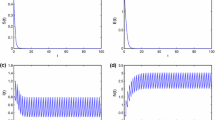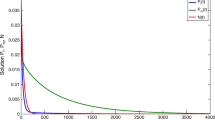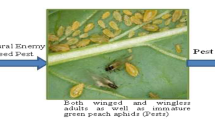Abstract
This paper formulates a robust stage-structured SI eco-epidemiological model with periodic constant pulse releasing of infectious pests with pathogens. The authors show that the conditions for global attractivity of the ‘pest-eradication’ periodic solution and permanence of the system depend on time delay, hence, the authors call it “profitless”. Further, the authors present a pest management strategy in which the pest population is kept under the economic threshold level (ETL) when the pest population is uniformly persistent. By numerical analysis, the authors also show that constant maturation time delay for the susceptible pests and pulse releasing of the infectious pests can bring obvious effects on the dynamics of system.
Similar content being viewed by others
References
V. M. Stern, Economic thresholds, Ann. Rev. Entomol, 1973, 18(1): 259–280.
J. van Lenteren, Integrated pest management in protected crops, in Integrated Pest Management (ed. by D. Dent), Chapman & Hall, London, 1995.
J. van Lenteren and J. Woets, Biological and integrated pest control in greenhouses, Ann. Rev. Ent., 1998, 33(1): 239–250.
J. Lü and G. Chen, A new chaotic attractor coined, International Journal of Bifurcation and Chaos, 2002, 12(3): 659–661.
J. Lü, G. Chen, D. Cheng, and S. Celikovsky, Bridge the gap between the Lorenz system and the Chen system, International Journal of Bifurcation and Chaos, 2002, 12(12): 2917–2926.
L. Falcon, Use of bacteria for microbial control of insetts, Microbial Control of Insects and Mites (ed. by H. D. Burges and N. W. Hussey), Academic Press, New York, 1971.
H. Burges and N. Hussey, Microbial Control of Insects and Mites, Academic Press, New York, 1971.
Y. Tanada, Epizootiology of insect diseases, Biological Control of Insect Pests and Weeds (ed. by P. DeBach), Chapman & Hall, London, 1964.
L. Falcon, Problems associated with the use of arthropod viruses in pest control, Annu. Rev. Entomol., 1976, 21(2): 305–324.
R. Anderson and R. May, Regulation and stability of host-parasite population interactions, I. Regulatory processes, J. Anim. Ecol., 1978, 47(1): 219–247.
W. Aiello and H. Freedman, A time-delay model of single-species growth with stage structure, Math. Biosci., 1990, 101: 139–153.
Y. Xiao, L. Chen, and F. Bosch, Dynamical behavior for a stage-structured SIR infectious disease model, Nonlinear Analysis: Real Word Applications, 2002, 3(2): 175–190.
X Song and L Chen, Optimal harvesting and stability for a two-species competitive system with stage structure, Math. Biosci., 2001, 170(2): 173–186.
S. Gourley and Y. Kuang, A stage-structured predator-prey model and its dependence on through-stage delay and death rate, J. Math. Biol., 2004, 49(2): 188–200.
S. Liu and E. Beretta, A stage-structured predator-prey model of beddington-deangelis, Type. Siam J. Appl. Math, 2006, 66(4): 1101–1129.
J. Hui and D. Zhu, Dynamic complexities for prey-dependent consumption integrated pest management models with impulsive effects, Chaos, Solitons and Fractals, 2006, 29(1): 233–251.
A. Hastings, Age-dependent predation is not a simple process, I. Continuous time models, Theor. Popul. Biol., 1983, 23(1): 47–62.
D. Bainov and P. Simeonov, System with Impulsive Effect: Stability, Theory and Applications, John Wiley and Sons, New York, 1989.
V. Lakshmikantham, D. Bainov, and P. Simeonov, Theory of Impulsive Differential Equations, World Scienti. C, Singapore, 1989.
S. Ruan and W. Wang, Dynamical behavior of an epidemic model with a nonlinear incidence rate, J. Differential Equations, 2003, 188(1): 135–163.
S. Zhang and L. Chen, The study of predator-prey system with defensive ability of prey and impulsive perturbations on the predator, Chaos, Solitons and Fractals, 2005, 23(2): 631–643.
B. Liu, Y. Zhang, and L. Chen, The dynamical behaviors of a Lotka-Volterra predator-prey model concerning integrated pest management, Nonlinear Analysis: Real World Applications, 2005, 6: 227–243.
B. Liu, L. Chen, and Y. Zhang, The dynamics of a prey-dependent consumption model concerning impulsive control strategy, Applied Mathematics and Computation, 2005, 169(1): 305–320.
X. Meng, J. Jiao, and L. Chen, The dynamics of an age-structured predator-prey model with disturbing pulse and time delays, Nonlinear Analysis: Real World Applications, 2008, 9(2): 547–561.
X. Meng, Z. Song, and L. Chen, A new mathematical model for optimal control strategies of integrated pest management, Journal of Biological Systems, 2007, 15(2): 219–234.
Author information
Authors and Affiliations
Corresponding author
Additional information
*This research is supported by the National Natural Science Foundation of China under Grant No. 10471117, 10771179, and the Natural Science and Development Foundation of Shandong University of Science and Technology under Grant No. 05g016.
Rights and permissions
About this article
Cite this article
Meng, X., Chen, L. A STAGE-STRUCTURED SI ECO-EPIDEMIOLOGICAL MODEL WITH TIME DELAY AND IMPULSIVE CONTROLLING*. J Syst Sci Complex 21, 427–440 (2008). https://doi.org/10.1007/s11424-008-9124-8
Received:
Revised:
Published:
Issue Date:
DOI: https://doi.org/10.1007/s11424-008-9124-8




